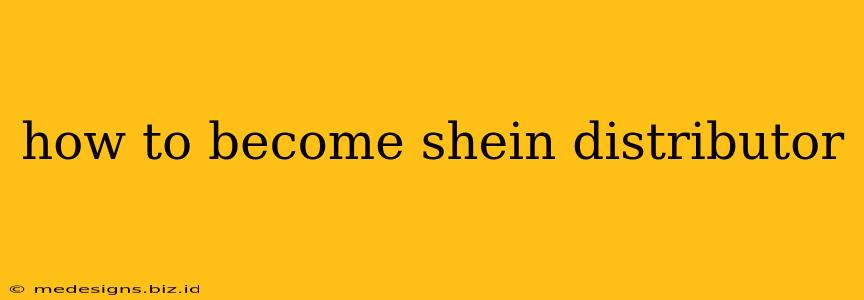Want to become a SHEIN distributor and tap into the booming fast-fashion market? This guide breaks down everything you need to know, from understanding the SHEIN business model to exploring alternative options if direct distribution isn't feasible.
Understanding SHEIN's Business Model
Before diving in, it's crucial to understand that SHEIN doesn't operate a traditional wholesale or distributor program in the same way as many other brands. They primarily focus on direct-to-consumer sales through their own website and app. This means there isn't a readily available application process to become an official SHEIN distributor.
This doesn't mean you can't sell SHEIN products, but it requires a different approach. Let's explore your options:
Alternative Ways to Sell SHEIN Products
While you can't become an official SHEIN distributor, there are several strategies you can employ to sell their products and build your own business:
1. Reselling on Third-Party Marketplaces:
This is perhaps the most common approach. Platforms like eBay, Amazon, and Poshmark allow individuals to resell items, including SHEIN clothing and accessories. You'll need to:
- Purchase items directly from SHEIN: Buy products at retail prices.
- List your items: Create compelling listings with high-quality photos and accurate descriptions.
- Manage your inventory: Keep track of your stock levels and fulfill orders promptly.
- Handle customer service: Respond to customer inquiries and resolve any issues efficiently.
Pros: Relatively easy setup, access to a large customer base. Cons: Higher initial investment (buying inventory), competition from other resellers, lower profit margins.
2. Building Your Own Online Store:
Creating your own e-commerce website gives you more control and branding opportunities. However, it requires significantly more effort and investment, including:
- Website development: Choose a platform like Shopify or WooCommerce.
- Marketing and advertising: Drive traffic to your website through SEO, social media marketing, and paid advertising.
- Order fulfillment: Manage shipping and returns.
- Customer service: Provide excellent customer support.
Pros: Higher profit margins, complete control over branding and pricing. Cons: Higher initial investment and ongoing costs, requires more marketing effort.
3. Dropshipping (With Caution):
Dropshipping involves selling products without holding inventory. While technically feasible with SHEIN, it presents challenges:
- SHEIN doesn't explicitly support dropshipping: Their terms of service may prohibit this practice.
- Order fulfillment complexities: SHEIN's shipping times may be inconsistent, potentially affecting customer satisfaction.
- Branding limitations: You have less control over packaging and branding.
Pros: Low initial investment. Cons: High risk of violating SHEIN's terms of service, potential for customer dissatisfaction due to inconsistent shipping.
Important Considerations Before Proceeding:
- SHEIN's Terms of Service: Carefully review SHEIN's terms of service to understand any restrictions on reselling their products. Violation could lead to account suspension or legal action.
- Profit Margins: Selling SHEIN products requires careful consideration of pricing to ensure profitability after accounting for purchase costs, shipping, fees, and marketing expenses.
- Competition: The market is competitive. You'll need a strong marketing strategy to stand out.
- Customer Service: Providing exceptional customer service is critical to building a successful business.
Conclusion:
While becoming an official SHEIN distributor is not currently possible, several alternative avenues exist for selling SHEIN products. Choose the path that best aligns with your resources, skills, and risk tolerance. Remember to always operate within SHEIN's terms of service and prioritize providing excellent customer service to build a thriving business.
